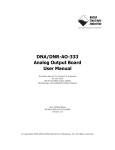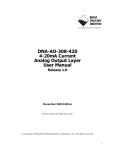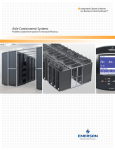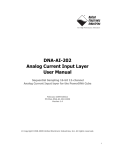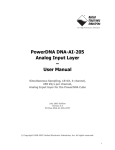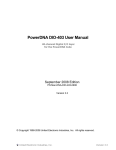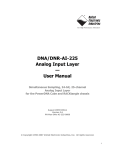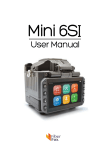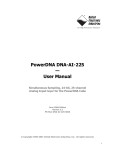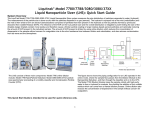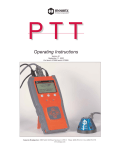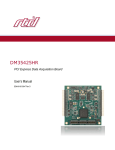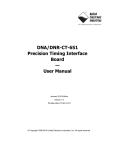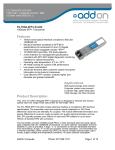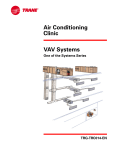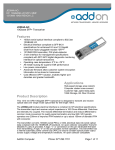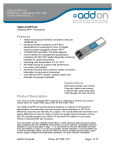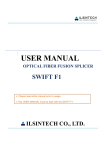Download DNA-AO-308-350 High Current Analog Output Layer User Manual
Transcript
DNA-AO-308-350 High Current Analog Output Layer User Manual Version 1.4 July 2009 Edition PN Man-DNA-AO-308-350-0709 © Copyright 1998-2009 United Electronic Industries, Inc. All rights reserved. i DNA-AO-308-350 User Manual No part of this publication may be reproduced, stored in a retrieval system, or transmitted, in any form by any means, electronic, mechanical, by photocopying, recording, or otherwise without prior written permission. Information furnished in this manual is believed to be accurate and reliable. However, no responsibility is assumed for its use, or for any infringement of patents or other rights of third parties that may result from its use. All product names listed are trademarks or trade names of their respective companies. See the UEI website for complete terms and conditions of sale: http://www.ueidaq.com/company/terms.aspx Contacting United Electronic Industries Mailing Address: 27 Renmar Avenue Walpole, MA 02081 U.S.A. For a list of our distributors and partners in the US and around the world, please see http://www.ueidaq.com/partners/ Support: Telephone: Fax: (508) 921-4600 (508) 668-2350 Also see the FAQs and online “Live Help” feature on our web site. Internet Support: Support: Web-Site: FTP Site: [email protected] www.ueidaq.com ftp://ftp.ueidaq.com Product Disclaimer: WARNING! DO NOT USE PRODUCTS SOLD BY UNITED ELECTRONIC INDUSTRIES, INC. AS CRITICAL COMPONENTS IN LIFE SUPPORT DEVICES OR SYSTEMS. Products sold by United Electronic Industries, Inc. are not authorized for use as critical components in life support devices or systems. A critical component is any component of a life support device or system whose failure to perform can be reasonably expected to cause the failure of the life support device or system, or to affect its safety or effectiveness. Any attempt to purchase any United Electronic Industries, Inc. product for that purpose is null and void and United Electronics Industries, Inc. accepts no liability whatsoever in contract, tort, or otherwise whether or not resulting from our or our employees' negligence or failure to detect an improper purchase. ii iii Table of Contents Chapter 1 Introduction .................................................... 1 1.1 1.1.1 1.1.2 1.1.3 1.1.4 Organization . . . . . . . . . . . . . . . . . . . . . . . . . . . . . . . . . . . . . . . . . . . . . . . . . . . . . . . . Introduction . . . . . . . . . . . . . . . . . . . . . . . . . . . . . . . . . . . . . . . . . . . . . . . . . . . DNA-AO-308-350 Layer. . . . . . . . . . . . . . . . . . . . . . . . . . . . . . . . . . . . . . . . . . Programming with the High-Level API . . . . . . . . . . . . . . . . . . . . . . . . . . . . . . . Programming with the Low-Level API . . . . . . . . . . . . . . . . . . . . . . . . . . . . . . . 1 1 1 1 1 1.2 The DNA-AO-308 Series Analog Output Layers. . . . . . . . . . . . . . . . . . . . . . . . . . . . . 2 1.3 Device Architecture. . . . . . . . . . . . . . . . . . . . . . . . . . . . . . . . . . . . . . . . . . . . . . . . . . . 4 1.4 1.4.1 Layer Connectors and Wiring . . . . . . . . . . . . . . . . . . . . . . . . . . . . . . . . . . . . . . . . . . . 5 Connectors. . . . . . . . . . . . . . . . . . . . . . . . . . . . . . . . . . . . . . . . . . . . . . . . . . . . 5 Chapter 2 Programming with the High-Level API . . . . . . . . . . . . . . . . . . . . . . . . . . . . . . . 7 2.1 2.1.1 2.1.2 2.1.3 2.1.4 2.1.5 Programming with the Ueidaq Framework API. . . . . . . . . . . . . . . . . . . . . . . . . . . . . . Creating a Session. . . . . . . . . . . . . . . . . . . . . . . . . . . . . . . . . . . . . . . . . . . . . . Configuring the Channels . . . . . . . . . . . . . . . . . . . . . . . . . . . . . . . . . . . . . . . . Configuring the Timing . . . . . . . . . . . . . . . . . . . . . . . . . . . . . . . . . . . . . . . . . . . Writing Data . . . . . . . . . . . . . . . . . . . . . . . . . . . . . . . . . . . . . . . . . . . . . . . . . . . Cleaning-up the Session . . . . . . . . . . . . . . . . . . . . . . . . . . . . . . . . . . . . . . . . . 7 7 7 7 8 8 Chapter 3 Programming with the Low-Level API . . . . . . . . . . . . . . . . . . . . . . . . . . . . . . . 9 3.1 Configuration Settings. . . . . . . . . . . . . . . . . . . . . . . . . . . . . . . . . . . . . . . . . . . . . . . . . 9 3.2 Channel List Settings . . . . . . . . . . . . . . . . . . . . . . . . . . . . . . . . . . . . . . . . . . . . . . . . 11 3.3 Data Representation . . . . . . . . . . . . . . . . . . . . . . . . . . . . . . . . . . . . . . . . . . . . . . . . . 11 3.4 Layer-specific Commands and Parameters . . . . . . . . . . . . . . . . . . . . . . . . . . . . . . . 12 3.5 Using the Layer in ACB Mode. . . . . . . . . . . . . . . . . . . . . . . . . . . . . . . . . . . . . . . . . . 12 3.6 Using the Layer in DMap Mode . . . . . . . . . . . . . . . . . . . . . . . . . . . . . . . . . . . . . . . . 14 Appendices . . . . . . . . . . . . . . . . . . . . . . . . . . . . . . . . . . . . . . . . . . . . . . . . . . . . . . . . . . . . . . 17 Accessories . . . . . . . . . . . . . . . . . . . . . . . . . . . . . . . . . . . . . . . . . . . . . . . . . . . . . . . . 17 Calibration . . . . . . . . . . . . . . . . . . . . . . . . . . . . . . . . . . . . . . . . . . . . . . . . . . . . . . . . . 17 Index . . . . . . . . . . . . . . . . . . . . . . . . . . . . . . . . . . . . . . . . . . . . . . . . . . . . . . . . . . . . . . . . . . 19 © Copyright 2009 United Electronic Industries, Inc. Tel: 508-921-4600 Date: July 2009 www.ueidaq.com Vers: 1.4 File:AO-308-350TOC.fm iv List of Figures 1-1 1-2 1-3 1-4 1-5 DNA-AO-308-350 Board ................................................................................................ 4 Block Diagram of DNA-AO-308-350 Device Architecture .............................................. 4 DNA-AO-308-350 DB-37 I/O Connector Pinout............................................................. 5 Physical Layout of DNA-AO-308-350 Layer Board........................................................ 6 Diagram of DNA-AO-308-350 Layer Position Jumper Settings ..................................... 6 © Copyright 2009 United Electronic Industries, Inc. Tel: 508-921-4600 Date: July 2009 www.ueidaq.com Vers: 1.4 File:AO-308-350LOF2.fm v List of Tables 1-1 3-1 3-2 DNA-AO-308-350 Technical Specifications................................................................................... 3 DNA-AO-308 Layer Channel List Structure ................................................................................ 11 DNA-AO-308x Layer Channel List Structure .............................................................................. 11 © Copyright 2009 United Electronic Industries, Inc. Tel: 508-921-4600 Date: July 2009 www.ueidaq.com Vers: 14 File:AO-308-350LOT.fm Chapter 1 Introduction Chapter 1 Introduction This document outlines the feature set and use of the DNA-AO-308-350 high current analog output layer when used with the PowerDNA Core Module. This manual describes the following products: • DNA-AO-308-350 true 16-bit, 8-channel, High Current, ±10V Analog Output Layer with per-channel digital offset and gain calibration, buffered output, excellent linearity, and low noise. It features current boosters that allow up to ±50 mA current draw per channel and sense lines for better accuracy • Accessory modules such as cables and screw terminal panels 1.1 Organization This DNA AO-308--350 User Manual is organized as follows: 1.1.1 Introduction This chapter provides an overview of DNA-AO-308-350 board/layer features, accessories, and what you need to get started. 1.1.2 DNA-AO-308350 Layer This chapter provides an overview of the device architecture, connectivity, logic, and accessories for the DNA-AO-308-350 layer board. 1.1.3 Programming This chapter provides a general overview of procedures that show how with the High- to create a session, configure the session, and generate output on a DNA-AO-308-350 layer, working with the UEIDAQ Framework HighLevel API Level API. 1.1.4 Programming with the LowLevel API This chapter describes the Low-Level API commands for configuring and using a DNA-AO-308-350 layer. Appendices A. Accessories This appendix provides a list of accessories available for use with a DNA-AO-308-350 layer. B. Calibration This appendix outlines the recommended calibration procedure for a DNA-AO-308-350 board/layer. Index This is an alphabetical index of topics covered in this manual. NOTE: A glossary of terms used with the PowerDNA Cube and Layers can be viewed and/or downloaded from www.ueidaq.com. © Copyright 2009 United Electronic Industries, Inc. Tel: 508-921-4600 Date: July 2009 www.ueidaq.com Vers: 1.4 File:AO-308-350 Chap1.fm 1 Chapter 1 Introduction Manual Conventions To help you get the most out of this manual and our products, please note that we use the following conventions: Tips are designed to highlight quick ways to get the job done, or reveal good ideas you might not discover on your own. NOTE: Notes alert you to important information. CAUTION! Caution advises you of precautions to take to avoid injury, data loss, and damage to your boards or a system crash. Text formatted in bold typeface generally represents text that should be entered verbatim. For instance, it can represent a command, as in the following example: “You can instruct users how to run setup using a command such as setup.exe.” 1.2 The The DNA-AO-308x series of Analog Output boards/layers includes the DNA-AO-308 following products: Series • DNA-AO-308 16-bit, 8-channel, ±10V Analog Output Board/Layer Analog • DNA-AO-308-350 16-bit, 8-channel, ±10V, High Current Analog Output Output Board/Layer Layers • DNA-AO-308-353 16-bit, 8-channel, ±40V, High Voltage Analog Output Board/Layer • DNA-AO-308-420 16-bit, 8-channel, 4-20 mA Current Analog Output Board/Layer This manual describes the DNA-AO-308-350 High Current, 16-bit, 8channel, ±10V Analog Output Board/Layer only The other products in the series are described in separate documents. Using a DNA-AO-308-350 instead of a DNA-AO-308 boosts current capability to 100 mA per channel. It uses ±15V, which is available internally on the board, or additional power at ±15V, ±24V, or ±45V from a power conversion layer installed in the PowerDNA Cube. The technical specifications for the DNA-AO-308-350 High Current Analog Output Layer are listed in Table 1-1. © Copyright 2009 United Electronic Industries, Inc. Tel: 508-921-4600 Date: July 2009 www.ueidaq.com Vers: 1.4 File:AO-308-350 Chap1.fm 2 Chapter 1 Introduction Table 1-1. DNA-AO-308-350 Technical Specifications p Number of Channels Resolution Max Update Rate: @ 16-bit resolution @ 12-bit resolution @ 9-bit resolution Buffer Size Type of D/A INL (no load) DNL (no load) Monotonicity Over Temperature Gain Linearity Error Gain Calibration Error Offset Calibration Error Offset Drift Gain Drift Output Range Output Coupling Output Impedance Current Drive Capacitive Loads Settling Time Slew Rate Isolation Power Consumption1 Physical Dimensions Operating Temp. (tested) Operating Humidity 8 16 bits 100 kHz/channel (800kHz max aggregate) 200 kHz/channel (800kHz max aggregate) 400 kHz/channel (800kHz max aggregate) 1K samples double-buffered ±1 LSB (0.003%) ±1 LSB (0.003%) 16 bits 0.002% ±150 μV ±100 μV 5ppm/°C 5ppm/°C ±10V DC 0.1Ω max ±50mA/channel 1000 pF 10 μs to 16 bits 10 V/μs 350Vrms 1.5W - 11W 3.875” x 3.875” (98 x 98 mm) -40°C to +85°C 90%, non-condensing 1 1 the total total power power consumption is is over the4.5W, 4.5W,athe DNA-FANxrear-mount rearIfIf the consumptionofofthe thelayer layer over DNA-FANx mount is requited. the Typical Performance Characteristicsfor formore coolingcooling fan is fan required. ReferRefer to thetoTypical Performance Characteristics more detail.details. © Copyright 2009 United Electronic Industries, Inc. Tel: 508-921-4600 Date: July 2009 www.ueidaq.com Vers: 1.4 File:AO-308-350 Chap1.fm 3 Chapter 1 Introduction Figure 1-1 is a photo of the DNA-AO-308-350 Layer board. 120-pin DNA bus connector IRQ Jumpers (Do not change) Layer Position Jumpers (see Figure 1-4) Power Connector DB-37 (female) 37-pin I/O connector Figure 1-1. DNA-AO-308-350 Board 1.3 Device The DNA-AO-308-350 High Current Analog Output Layer board has Architecture eight individual analog output channels. A Block Diagram of the board/ layer is shown in Figure 1-2. Block Diagram: -15V (50mA) +15V (50mA) Curr. Boost ... ... Control Logic AOut7 Force AOut7 Sense Curr. Boost DC/DC (12W) 16-bit D/A 16-bit D/A Protection DIO (3) Calibration Reference Control Logic 32-bit 66-MHz bus AOut0 Sense Optical Isolation Analog Output Connector AOut0 Force Calibration EEPROM Figure 1-2. Block Diagram of DNA-AO-308-350 Device Architecture © Copyright 2009 United Electronic Industries, Inc. Tel: 508-921-4600 Date: July 2009 www.ueidaq.com Vers: 1.4 File:AO-308-350 Chap1.fm 4 Chapter 1 Introduction 1.4 Layer Connectors and Wiring NOTE: 1.4.1 The DNA-AO-308-350 High Current Analog Output board is designed with separate force and sense lines. Be sure to short the AOUTn and AOUTn sense lines whenever an output is not connected to an external circuit. If output and sense lines are left open-circuited, the output amplifier feedback circuitry is open, causing the signal to drift either to the positive or to the negative side of the power supply rail. Connectors The pinout of the 37-pin connector for the DNA-AO-308-350 Layer board is shown in Figure 1-3. A physical layout of the board is shown in Figure 1-4. . DB-37 (female) 37-pin connector: AOUT0 SENSE AGND AOUT1 AOUT2 SENSE AGND AOUT3 AOUT4 SENSE AGND AOUT5 AOUT6 SENSE AGND AOUT7 DN/C AGND AGND DIO2 AGND –12V (50mA) OUT 37 36 35 34 33 32 31 30 29 28 27 26 25 24 23 22 21 20 19 18 17 16 15 14 13 12 11 10 9 8 7 6 5 4 3 2 1 AGND AOUT0 AOUT1 SENSE AGND AOUT2 AOUT3 SENSE AGND AOUT4 AOUT5 SENSE AGND AOUT6 AOUT7 SENSE AGND DN/C AGND DIO1 DIO0 +12V (50mA) OUT AGND Note: All analog grounds (AGND) should be tied together for better accuracy. Figure 1-3.DNA-AO-308-350 DB-37 I/O Connector Pinout © Copyright 2009 United Electronic Industries, Inc. Tel: 508-921-4600 Date: July 2009 www.ueidaq.com Vers: 1.4 File:AO-308-350 Chap1.fm 5 Chapter 1 Introduction 1 2 3 4 5 6 7 8 9 10 11 12 13 14 15 16 DNA 120-pin Bus Connector J1 Factory Use Only See Figure 1-5 for jumper locations for setting layer position. Power Connector DB-37 I/O Connector External Circuits Figure 1-4. Physical Layout of DNA-AO-308-350 Layer Board 1.4.1.1 Jumper Settings A diagram of the jumper block is shown in Figure 1-4. To set the layer position jumpers, place jumpers as shown in Figure 1-5. Jx Pins I/O 1 Layer’s Position as marked on the Faceplate* I/O 2 I/O 3 I/O 4 I/O 5 I/O 6 9-10 11-12 13-14 15-16 * All I/O Layers are sequentially enumerated from top to the bottom of the Cube - Open - Closed Figure 1-5. Diagram of DNA-AO-308-350 Layer Position Jumper Settings © Copyright 2009 United Electronic Industries, Inc. Tel: 508-921-4600 Date: July 2009 www.ueidaq.com Vers: 1.4 File:AO-308-350 Chap1.fm 6 Chapter 2 Programming with the High-Level API Chapter 2 2.1 Programming with the High-Level API Programming with the Ueidaq Framework API This section describes how to program the DNA-AO-308x (AO-308, AO308-350, AO-308-353, AO-308-420) board/layer using the UeiDaq Framework High-Level API. The UeiDaq Framework is object-oriented. Its objects can be manipulated in the same manner within various development environments, such as Visual C++, Visual Basic, or LabVIEW. Although the following section focuses on the C++ API, the concept is the same for any programming language you use. Please refer to the “UeiDaq Framework User Manual” for more information on using other programming languages. Please refer to the examples that come with the UeiDaq Framework. They contain detailed and commented code that can be compiled and executed. 2.1.1 Creating a Session The Session object controls all operations on your PowerDNA device. Therefore, the first task is to create a session object, by entering: CUeiSession session; 2.1.2 Configuring the Channels Framework uses resource strings to select which device, subsystem, and channels you use within a session. The resource string syntax is similar to a web URL, as: <device class>://<IP address>/<Device Id>/ <Subsystem><Channel list> For PowerDNA, the device class is pdna. For example, the following resource string selects analog output channels 0,1 on device 1 at IP address 192.168.100.2: “pdna:// 192.168.100.2/Dev1/Ao0:1” // Configure channels 0,1 with an output // range of ±10V (or 4-20 mA for the AO-420) session.CreateAOChannel("pdna://192.168.100.2/ Dev0/ao0:1",-10.0, 10.0); 2.1.3 Configuring the Timing You can configure the DNA-AO-308x layer to run either in simple mode (point by point) or buffered mode (ACB mode). In simple mode, the delay between samples is determined by software on the host computer. In buffered mode, the delay between samples is determined by the DNAAO-308x on-board clock. © Copyright 2009 United Electronic Industries, Inc. Tel: 508-921-4600 Date: July 2009 www.ueidaq.com Vers: 1.4 File:AO-308-350 Chap2.fm 7 Chapter 2 Programming with the High-Level API The following sample shows how to configure the simple mode. Please refer to the “UeiDaq Framework User Manual” to learn how to use the other timing modes. session.ConfigureTimingForSimpleIO(); 2.1.4 Writing Data Writing data to the DNA-AO-308x board/layers is done with a writer object. You can create a writer object that writes raw data straight to the D/A converter. You can also create a writer object that writes data scaled to volts. Framework automatically performs a conversion to binary code before sending the data to the D/A converter. The following sample code shows how to create a scaled writer object and write a sample. // Create a reader and link it to the // session’s stream CueiAnalogScaledWriter writer(session.GetDataStream()); // write one scan, the buffer must contain // one value // for each channel double data[2] = {0.0, 0.0}; writer.WriteSingleScan(data); Similarly, you can create a raw writer object by entering the following: // Create a reader and link it to the session’s stream CUeiAnalogRawWriter writer(session.GetDataStream()); // write one scan, the buffer must contain one value // for each channel uInt16 data[2] = {0x1234, 0x5678}; writer.WriteSingleScan(data); All the 308x analog output layers are programmed the same way. 2.1.5 Cleaning-up the Session The session object cleans itself up when it goes out of scope or when it is destroyed. If you want to reuse the object with a different set of channels or parameters, you can manually clean up the session with the following: session.CleanUp(); © Copyright 2009 United Electronic Industries, Inc. Tel: 508-921-4600 Date: July 2009 www.ueidaq.com Vers: 1.4 File:AO-308-350 Chap2.fm 8 DNA-AO-308-350 Layer Chapter 3 Programming with the Low-Level API Chapter 3 Programming with the Low-Level API This section describes how to program the PowerDNA cube using the low-level API. The low-level API offers direct access to PowerDNA DAQBIOS protocol and also allows you to access device registers directly. We recommend that, where possible, you use the UeiDaq Framework high-level API (see “Programming with the Ueidaq Framework API” on page 7), which is easier to use than the low-level API. You need to use the low-level API only if you are using an operating system other than Windows. 3.1 Configuration Configuration settings are passed in DqCmdSetCfg() and DqAcbInitOps() functions. Settings Not all configuration bits apply to DNA-AO-308x series (AO-308, AO308-350, AO-308-353, AO-308-420) boards/layers, however. The following bits make sense: #define DQ_FIFO_MODEFIFO (2L << 16) // continuous acquisition with FIFO #define DQ_LN_MAPPED (1L<<15) // For WRRD (DMAP) devices //(automatically selected) #define DQ_LN_STREAMING (1L<<14) // For RDFIFO devices - stream the FIFO data //(automatically selected) For WRFIFO - do NOT //send reply to WRFIFO unless needed #define DQ_LN_IRQEN (1L<<10) //enable layer irqs #define DQ_LN_PTRIGEDGE1 (1L<<9) // stop trigger edge MSB #define DQ_LN_PTRIGEDGE0 (1L<<8) // stop trigger edge: 00 - software, // 01 - rising, 02 – falling #define DQ_LN_STRIGEDGE1 (1L<<7) // start trigger edge MSB #define DQ_LN_STRIGEDGE0 (1L<<6) // start trigger edge: 00 - software, //01 -rising, 02 - falling #define DQ_LN_CVCKSRC1 (1L<<5) // CV clock source MSB #define DQ_LN_CVCKSRC0 (1L<<4) // CV clock source 01 - SW,10 - HW, 11 –EXT #define DQ_LN_CLCKSRC1 (1L<<3) // CL clock source MSB #define DQ_LN_CLCKSRC0 (1L<<2) // CL clock source 01 - SW,10 - HW,11 –EXT #define DQ_LN_ACTIVE (1L<<1) © Copyright 2009 United Electronic Industries, Inc. Tel: 508-921-4600 Date: July 2009 www.ueidaq.com Vers: 1.4 File: AO-308-350 Chap3.fm 9 DNA-AO-308-350 Layer Chapter 3 Programming with the Low-Level API // "STS" LED status #define DQ_LN_ENABLED (1L<<0) // enable operations For streaming operations with hardware clocking, select the following flags: DQ_LN_ENABLE | DQ_LN_CVCKSRC0 | DQ_LN_STREAMING | DQ_LN_IRQEN | DQ_LN_ACTIVE | DQ_AO3xx_BI10 DNA-AO-308x has a range of layer-specific settings - as follows: The following modes are reserved for future use: #define DQ_AO3xx_MODEFIFO (1L << 19) // continuous output with FIFO #define DQ_AO3xx_MODECONT (2L << 19) // waveform mode – continuous #define DQ_AO3xx_MODECYCLE (3L << 19) // waveform mode – regenerate #define DQ_AO3xx_MODEWFGEN (4L << 19) // waveform mode - hardware DQ_LN_ENABLE enables all operations with the layer. DQ_LN_CVCKSRC0 selects the internal channel list clock (CL) source as a timebase. AO-308 supports CV clock. DQ_LN_ACTIVE is needed to switch on “STS” LED on the CPU layer. You can select either the CL or CV clock as a timebase. Because of the parallel architecture of AO-308x layer, either clock triggers all converters. Aggregate rate = Per-channel rate * Number of channels Note that acquisition rate cannot be selected on per-channel basis. © Copyright 2009 United Electronic Industries, Inc. Tel: 508-921-4600 Date: July 2009 www.ueidaq.com Vers: 1.4 File: AO-308-350 Chap3.fm 10 DNA-AO-308-350 Layer Chapter 3 Programming with the Low-Level API 3.2 Channel List Settings The DNA-AO-308x layers have the following channel list structure: Bit Name Purpose Comments 31 LNCL_NEXT Tells firmware that there is a next entry n the channel list 21 DQ_LNCL_UPDALL Check update line to update all Reserved DACs. 20 DQ_LNCL_WRITE Write data into the DAC, but do Reserved not update. 7...0 Channel number Table 3-1. DNA-AO-308 Layer Channel List Structure 3.3 Data Representation DNA-AO-308x has 16-bit straight binary data representation, as shown in Table 3-2. Layer Range/ Value 0x0 0x8000 0xFFFF Span Offset AO-308, 350, ±10V -10V 0 +10V 20V 0 AO-353 ±40V -40V 0 +40V 80V 0 AO-420 4-20mA 4mA 12mA 20mA 16mA 4mA Table 3-2. DNA-AO-308x Layer Channel List Structure To convert voltage into an A/D representation, use the following formula: Raw = (Volt+Offset)/(Span/0xFFFF), where Volt is the desired level in volts. To convert current into A/D representation (AO-308-420 only), use the following formula: Raw = (mA+Offset)/(Span/0xFFFF), where mA is the desired level in mA. © Copyright 2009 United Electronic Industries, Inc. Tel: 508-921-4600 Date: July 2009 www.ueidaq.com Vers: 1.4 File: AO-308-350 Chap3.fm 11 DNA-AO-308-350 Layer Chapter 3 Programming with the Low-Level API 3.4 Layer-specific Layer-specific functions are described in the DaqLibHL.h file. Commands DqAdv3xxWrite() and Parameters This function works using underlying DqCmdIoctl(). It uses the DQCMD_IOCTL command with the DQIOCTL_CVTCHNL function. When this function is called for the first time, the firmware terminates any ongoing operation on the device. Then, the firmware parses the channel list and writes the passed values one by one. Therefore, you cannot perform this function call when the layer is involved in any streaming or data mapping operations. Every write to the channel takes approximately 3.3µs. Thus, execution time for this function depends on the number of channels in the channel list. 3.5 Using the Layer in ACB Mode This is a pseudo-code example that highlights the sequence of functions needed to use ACB on the 308x layers. A complete example with error checking can be found in the directory SampleACB30x. Note that we use the #defines for a 30x for a DNA-AO-308x layer. #include "PDNA.h" // unit configuration word #define CFG3xx (DQ_LN_ENABLED \ |DQ_LN_ACTIVE \ |DQ_LN_GETRAW \ |DQ_LN_IRQEN \ |DQ_LN_CVCKSRC0 \ |DQ_LN_STREAMING \ |DQ_AI30x_MODEFIFO |DQ_AO30x_BI10) uint32 Config = CFG30x; STEP 1: Start DQE engine. #ifndef _WIN32 DqInitDAQLib(); #endif // Start engine DqStartDQEngine(1000*1, &pDqe, NULL); // Open communication with IOM hd0 = DqOpenIOM(IOM_IPADDR0, DQ_UDP_DAQ_PORT, TIMEOUT_DELAY, &RdCfg); // Receive IOM crucial identification data DqCmdEcho(hd0, DQRdCfg); // Set up channel list for (n = 0; n < CHANNELS; n++) { © Copyright 2009 United Electronic Industries, Inc. Tel: 508-921-4600 Date: July 2009 www.ueidaq.com Vers: 1.4 File: AO-308-350 Chap3.fm 12 DNA-AO-308-350 Layer Chapter 3 Programming with the Low-Level API CL[n] = n; } STEP 2: Create and initialize host and IOM sides. // Now we are going to test device // DqAcbCreate(pDqe, hd0, DEVN, DQ_SS0IN, &bcb); // Let’s assume that we are dealing with AI-201 //device dquser_initialize_acb_structure(); // Now call the function DqAcbInitOps(bcb, &Config, 0, //TrigSize, NULL, //pDQSETTRIG TrigMode, &fCLClk, 0, //float* fCVClk, &CLSize, CL, 0, //uint32* ScanBlock, &acb); printf("Actual clock rate: %f\n", fCLClk); // Now set up events DqeSetEvent(bcb, DQ_eFrameDone|DQ_ePacketLost|DQ_eBufferError|DQ_eP acketOOB); // Allocate data buffer datta = dquser_allocatebuffer(); // Pre-fill ACB with raw data dquser_prefillbuffer(data); DqAcbPutScansCopy(bcb, data, // buffer bufsize, // buffer size in //scans bufsize, // minimum size &size, // actual copied //size (from user // buffer into ACB) &avail); // available free // space in buffer STEP 3: Start operation. // Start operations DqeEnable(TRUE, &bcb, 1, FALSE); © Copyright 2009 United Electronic Industries, Inc. Tel: 508-921-4600 Date: July 2009 www.ueidaq.com Vers: 1.4 File: AO-308-350 Chap3.fm 13 DNA-AO-308-350 Layer Chapter 3 Programming with the Low-Level API STEP 4: Process data. // We will not use event notification at first // - just retrieve scans while (keep_looping) { DqeWaitForEvent(&bcb, 1, FALSE, EVENT_TIMEOUT, &events); if (events & DQ_eFrameDone) { // fill buffer with more data dquser_prefillbuffer(data); DqAcbPutScansCopy(bcb, data,// buffer bufsize, // buffer size MINRQ, // minimum size &size, // actual //copied size from //user buffer into //ACB &avail); // available free space //in buffer } } STEP 5: Stop operation. DqeEnable(FALSE, &bcb, 1, FALSE); STEP 6: Clean up. DqAcbDestroy(bcb); DqStopDQEngine(pDqe); DqCloseIOM(hd0); #ifndef _WIN32 DqCleanUpDAQLib(); #endif 3.6 Using the Layer in DMap Mode #include "PDNA.h" STEP 1: Start DQE engine. #ifndef _WIN32 DqInitDAQLib(); #endif // Start engine DqStartDQEngine(1000*10, &pDqe, NULL); // open communication with IOM hd0 = DqOpenIOM(IOM_IPADDR0, DQ_UDP_DAQ_PORT, TIMEOUT_DELAY, &DQRdCfg); © Copyright 2009 United Electronic Industries, Inc. Tel: 508-921-4600 Date: July 2009 www.ueidaq.com Vers: 1.4 File: AO-308-350 Chap3.fm 14 DNA-AO-308-350 Layer Chapter 3 Programming with the Low-Level API // Receive IOM crucial identification data DqCmdEcho(hd0, DQRdCfg); for (i = 0; i < DQ_MAXDEVN; i++) { if (DQRdCfg->devmod[i]) { printf("Model: %x Option: %x\n", DQRdCfg->devmod[i], DQRdCfg->option[i]); } else { break; } } STEP 2: Create and initialize host and IOM sides. DqDmapCreate(pDqe, hd0, &pBcb, UPDATE_PERIOD, &dmapin, &dmapout); STEP 3: Add channels into DMap. for (i = 0; i < CHANNELS; i++) { DqDmapSetEntry(pBcb, DEVN, DQ_SS0IN, i, DQ_ACB_DATA_RAW, 1, &ioffset[i]); } DqDmapInitOps(pBcb); DqeSetEvent(pBcb, DQ_eDataAvailable|DQ_ePacketLost|DQ_eBufferError|D Q_ePacketOOB); STEP 4: Start operation. DqeEnable(TRUE, &pBcb, 1, FALSE); STEP 5: Process data. while (keep_looping) { DqeWaitForEvent(&pBcb, 1, FALSE, timeout, &eventsin); if (eventsin & DQ_eDataAvailable) { printf("\ndata "); for (i = 0; i < CHANNELS; i++) { printf("%04x ", *(uint16*)ioffset[i]); } } } STEP 6: Stop operation. DqeEnable(FALSE, &pBcb, 1, FALSE); STEP 7: Clean up. DqDmapDestroy(pBcb); DqStopDQEngine(pDqe); © Copyright 2009 United Electronic Industries, Inc. Tel: 508-921-4600 Date: July 2009 www.ueidaq.com Vers: 1.4 File: AO-308-350 Chap3.fm 15 DNA-AO-308-350 Layer Chapter 3 Programming with the Low-Level API DqCloseIOM(hd0); #ifndef _WIN32 DqCleanUpDAQLib(); #endif © Copyright 2009 United Electronic Industries, Inc. Tel: 508-921-4600 Date: July 2009 www.ueidaq.com Vers: 1.4 File: AO-308-350 Chap3.fm 16 17 Appendices A. Accessories The following accessory items are available for use with the DNA-AO308-350 layer. DNA-CBL-37 This is a 3 ft., 37-way flat ribbon cable with one 37-pin male and one 37pin D-sub connector. Used to connect the DNA-AO-308-350 board to a 37terminal panel such as the DNA-STP-37. DNA-STP-37 This is a 37-way screw terminal panel that can be used for making external connections to the DNA-AO-308-350 layer and DNA-CBL-37 cable. NOTE: If the total power consumption of the layer exceeds 4.5W, a rear mount cooling fan such as the DNA-FAN5 (for 3-layer Cube) or DNA-FAN8 (for 5-layer Cube) should be added to the DNA Cube. B. Layer Calibration Calibration should be performed with a microvolt-resolution voltmeter. To calibrate the layer, first short-circuit all eight channel signal and return lines at the point of voltage measurement. Run a serial terminal program attached to the IOM serial port. Use “simod 1” command to calibrate the layer. Please note that once you perform layer calibration yourself, the factory calibration warranty is void. Calibration Procedure The calibration procedure for the DNA-AO-308-350 Layer (using a serial port terminal) is: STEP 1: Type “simod 1.” STEP 2: Select the device to be calibrated from the device table. STEP 3: Remove the short circuit from Channel 0 and attach a voltmeter to it. STEP 4: Repeat this step for each channel and output -10V to each by entering command “a” and value 0. STEP 5: Adjust the calibration of DAC 0 by entering command 0 and a hexadecimal value to set this DAC to (0x0 – 0xff). STEP 6: Adjust the calibration of DAC 0 to output –10.000V on channels 0 through 7. STEP 7: Output +10V on all channels by entering command “a” and value FFFF. © Copyright 2009 United Electronic Industries, Inc. Tel: 508-921-4600 Date: July 2009 www.ueidaq.com Vers: 1.4 File:AO-308-350 ChapAppx.fm 18 STEP 8: Attach voltmeter to channel 0 and adjust calibration to reach 10V on all channels (with an error not to exceed 1mV). STEP 9: When calibration is complete, enter “q” command and reply “y” if you want to save calibration values into EEPROM. STEP 10: Reset the PowerDNA cube to verify calibration. For all DNA-AO-308x series layer boards, we recommend annual factory recalibration at UEI. © Copyright 2009 United Electronic Industries, Inc. Tel: 508-921-4600 Date: July 2009 www.ueidaq.com Vers: 1.4 File:AO-308-350 ChapAppx.fm 19 Index Physical layout 6 Programming ACB Mode 12 Channel List Settings 11 Commands and Parameters Configuration Settings 9 Configuring Channels 7 Configuring the Timing 7 Creating a Session 7 Data Representation 11 DMap Mode 14 Low-Level AP 9 Writing Data 8 A Accessories 17 DNA-STP-3 17 Accesssories DNA-CBL-37 17 Architecture 4 B Block Diagram C 4 Calibration 17 Clibration Procedure 17 Connector, DB-37 Connectors 5 5 S D DNA-AO-308 Series Products F Framework High-Level API J Jumper Settings M 2 7 6 Manual Conventions 2 Manual Organization 1 P photo of DNA-AO-308 layer © Copyright 2009 United Electronic Industries, Inc. 12 settings clock 10 Specifications 3 Support ii Support email [email protected] Support FTP Site ftp ii //ftp.ueidaq.com ii Support Web Site www.ueidaq.com 4 Tel: 508-921-4600 Date: July 2009 ii www.ueidaq.com File: Vers: 1.4 AO-308-350IX.fm
























